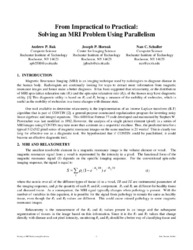From impractical to practical: solving an MRI problem using parallelism
| dc.contributor.author | Bak, Andrew | |
| dc.contributor.author | Hornak, Joseph | |
| dc.contributor.author | Schaller, Nan | |
| dc.date.accessioned | 2005-01-28T18:24:47Z | |
| dc.date.available | 2005-01-28T18:24:47Z | en_US |
| dc.date.issued | 2005 | |
| dc.identifier.uri | http://hdl.handle.net/1850/423 | |
| dc.description.abstract | MRI relaxometry may provide more diagnostic utility than conventional MRI because it measures molecular mobility, which changes with disease state. Processing relaxometry data requires applying an inverse Laplace transform (ILT). Applying ILT to typical MRI data would take months to complete using a conventional computer. This presentation focuses on parallelization of an ILT program. Results will be discussed along with the graphical analysis tool built to help process those results. | |
| dc.format.extent | 43694 bytes | en_US |
| dc.format.mimetype | application/pdf | en_US |
| dc.language.iso | en_US | |
| dc.subject | Magnetic resonance imaging | en_US |
| dc.subject | MRI relaxometry | en_US |
| dc.subject | Parallel programming | en_US |
| dc.title | From impractical to practical: solving an MRI problem using parallelism | |
| dc.type | Other |

